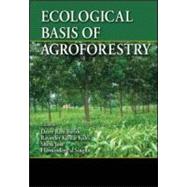- ISBN: 9781420043273 | 1420043277
- Cover: Hardcover
- Copyright: 11/15/2007
Faced with the growing problems of climate change, ecosystem degradation, declining agricultural productivity, and uncertain food security, modern agricultural scientists look for potential relief in an ancient practice. Agroforestry, if properly designed, can mitigate greenhouse effects, maintain ecosystem health and biodiversity, provide food security, and reduce poverty. Poorly implemented agroforestry, however, can not only exacerbate existing problems, but also contribute in its own right to the overall negative effects of our depleted and failing ecosystems. With a diminishing margin for error, a thorough understanding of the ecological processes that govern these complex systems is, therefore, crucial.Drawing on the collective expertise of world authorities, Ecological Basis of Agroforestry employs extensive use of tables and figures to demonstrate how ecologically sustainable agroecosystems can meet the challenges of enhancing crop productivity, soil fertility, and environmental sustainability. Divided into four sections, this comprehensive volume begins with a study of tree-crop interaction in tropical and temperate climates. Contributions cover above and below ground interactions, alley cropping, tri-trophic interactions, ecologically based pest management, and the chemistry and practical potential of chemically mediated plant interactions.The second section investigates root-mediated below ground interactions and their role in enhancing productivity, soil fertility, and sustainability. It includes an extensive study on litter dynamics and factors affecting nutrient release. Applying ecological modeling of complex agroforestry systems, section three demonstrates the use of computer-based designs to ensure profitability. The final section addresses the socio-economic aspects of agroforestry, supplying in-depth knowledge of various farming systems and discussing the technological tools that benefit society in different eco-regions around the world.






